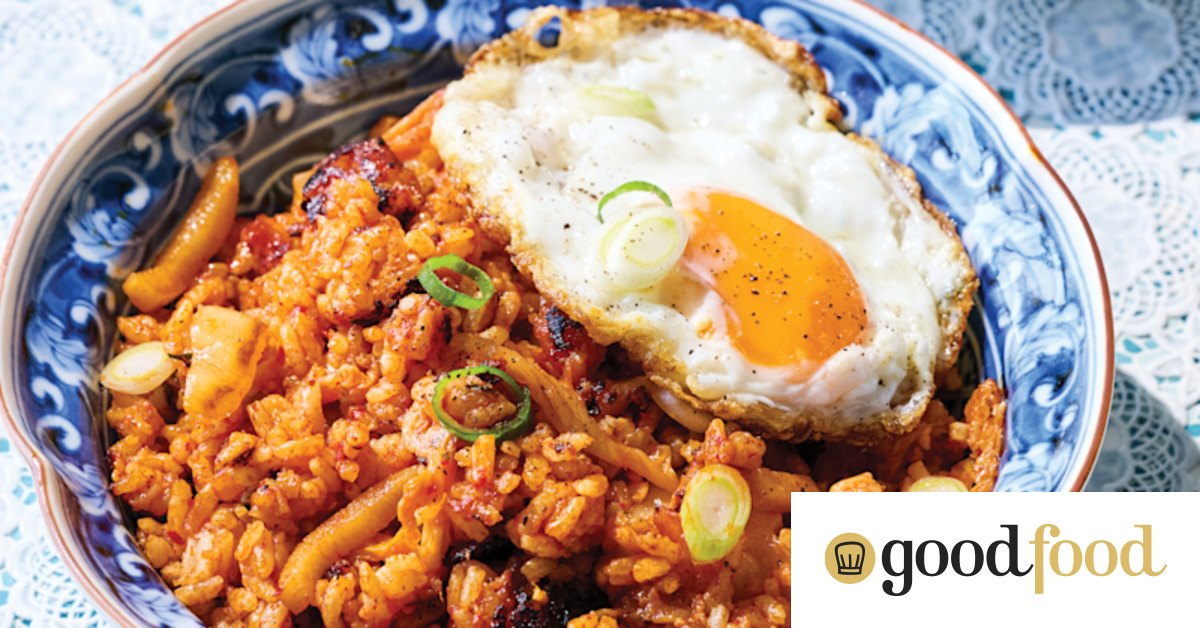Six essential Korean-style recipes everyone will love, starring this home-cooked meal that can be thrown together using nothing but leftovers.
You have reached your maximum number of saved items.
Remove items from your saved list to add more.
Save this article for later
Add articles to your saved list and come back to them anytime.
Victorian recipe developer and cookbook author Billy Law first fell for Korean food at a friend’s birthday dinner at a barbecue restaurant.
“Not just the flavours, but the whole experience,” he writes in his new recipe collection, Cook Korea! “Ten of us were gathered around a charcoal grill set into the table, surrounded by an astonishing array of sliced meats, fresh vegetables and spicy sauces and marinades. It was hot, smoky and noisy – and I was in heaven!”
Since that day, Law’s love of Korean cooking has grown into an obsession with every element of the cuisine, from the vibrant street-food scene, to traditional hot pots and the moreish bar snacks.
Here, Law shares his spin on favourite Korean-style recipes, including the easy and economical kimchi bokkeum bap (kimchi fried rice), the ever-popular japchae (sweet potato glass noodles) and the comforting and soul-satisfying spicy rice cakes called tteokbokki.
– Megan Johnston
Kimchi bokkeum bap (Kimchi fried rice)
Since you can throw kimchi fried rice together using nothing but leftovers, it’s an amazingly easy and economical dish – yet it still packs a huge flavour punch. This is a traditional favourite with university students who are living on a low budget. If I ever want a home-cooked meal but I am feeling too lazy to “cook”, kimchi fried rice always comes to the rescue.
INGREDIENTS
- 2 tbsp vegetable oil
- 2 garlic cloves, crushed
- 150g (1 cup) cabbage kimchi, roughly chopped
- 500g cooked short-grain rice
- 60ml kimchi juice
- 2 tbsp gochujang
- 2 tsp sesame oil
- salt and freshly ground black pepper, to taste
- 1 spring onion, thinly sliced
- 2 fried eggs, sunny-side up, to serve
METHOD
- Heat the vegetable oil in a large frying pan or wok over medium-high heat. Add the garlic and stir-fry for 1 minute until fragrant. Add the kimchi and stir-fry for another minute.
- Add the rice and use the back of a wooden spoon to break up any clumps. Add the kimchi juice and gochujang and stir-fry for 3-4 minutes, until well combined. Reduce the heat if the rice begins to stick to the base of the pan.
- Add the sesame oil and season with salt and pepper to taste. Add half the spring onion, mix well, then divide the fried rice between two bowls. Scatter with the remaining spring onion and top each bowl with a fried egg. Serve immediately.
Serves 2
Notes:
- When making fried rice, it is best to cook the rice a day ahead, then refrigerate overnight to draw out any excess moisture. That way, the rice will be drier and easier to cook as opposed to freshly cooked rice, which often turns soggy when you try to stir-fry it.
- You can also make a fancy version of this kimchi fried rice by adding thin slices of pork belly, bacon or even Spam.
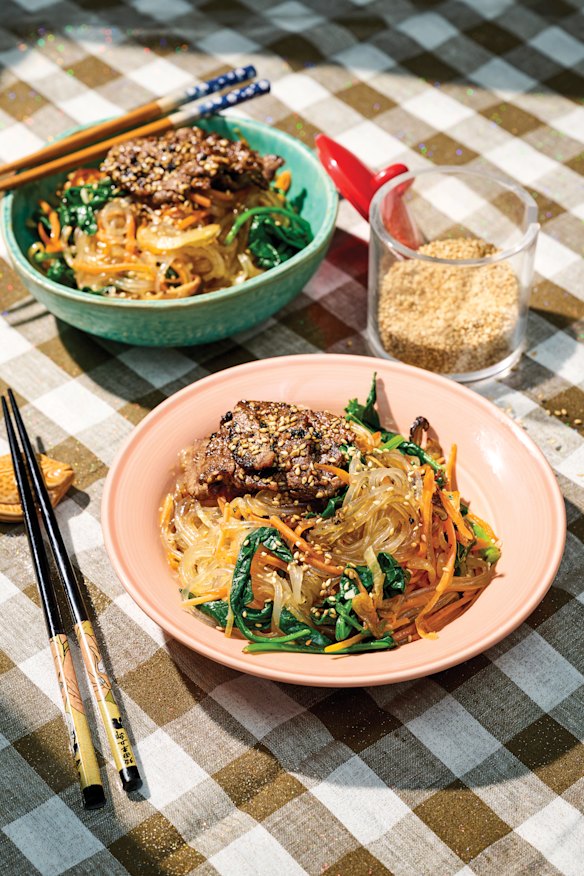
Japchae (Sweet potato glass noodles)
This has to be Korea’s most popular noodle dish – chewy, sweet and slightly slippery glass noodles tossed with juicy strips of beef bulgogi and stir-fried fresh vegetables. The best way to keep the colours bright is to make it like a salad: prepare everything separately and then gently toss together with your hands at the end.
INGREDIENTS
- 170g sweet potato starch noodles
- vegetable oil, for frying
- 1 onion, thinly sliced
- 1 spring onion, cut into 5cm lengths
- 1 carrot, cut into thin matchsticks
- 4-5 dried shiitake mushrooms, soaked in warm water for 2-3 hours, then cut into strips
- 110g soy-marinated barbecued beef, uncooked (see recipe below)
- ½ quantity seasoned English spinach (see recipe below)
Dressing
- 60ml (¼ cup) soy sauce
- 1 tbsp caster sugar
- 2 tbsp sesame oil
- 2 garlic cloves, finely chopped
- 2 tsp toasted sesame seeds
METHOD
- To make the dressing, whisk together all the ingredients in a small bowl until the sugar has dissolved.
- Cut the sweet potato starch noodles in half using a pair of kitchen scissors. Bring a saucepan of water to a rolling boil over high heat. Add the noodles and cook according to the packet instructions until soft and chewy. Drain the noodles and rinse under cold running water until chilled. Combine the noodles with 2 tablespoons of the dressing in a large bowl and mix well.
- Heat 1 tablespoon vegetable oil in a large non-stick frying pan or wok over medium heat. Add the noodles and stir-fry for 3-4 minutes, until the noodles are translucent. Return the noodles to the bowl.
- In the same pan, heat another tablespoon of oil, add the onion and spring onion and stir-fry for 1 minute, until the onion is a little translucent. Add the carrot and stir-fry for another minute, then transfer to the bowl with the noodles.
- Add 1-2 teaspoons of oil to the same pan, add the mushroom and bulgogi, and stir-fry for 2-3 minutes, until the beef has browned. Add to the noodles.
- Add the seasoned spinach to the noodle bowl, pour over the remaining dressing, and toss everything together with your hands. Taste and adjust the seasoning accordingly. Divide among serving bowls and serve warm.
Serves 4
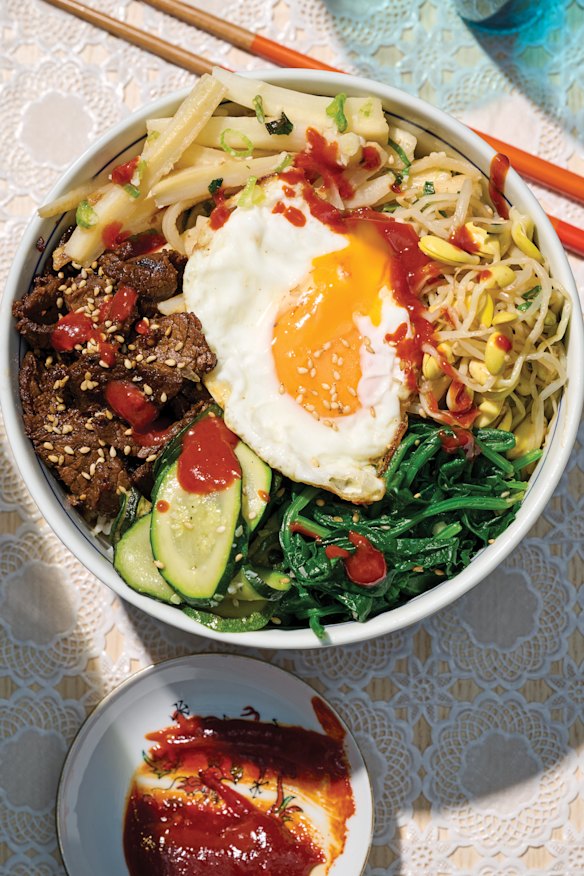
Bibimbap (Korean mixed rice bowl)
Bibimbap means “mixed rice” – which very much underplays the satisfying deliciousness on offer here. It’s one of Korea’s most famous dishes and it’s not hard to see why. Typically, a bibimbap is put together by using all the leftover banchan (side dishes) you have sitting in the fridge, so feel free to add as much or as little of each topping as you like. If you ever have leftover bulgogi from the barbecue, use it here; if not, make this simple pan-fried version.
INGREDIENTS
- 440g (2 cups) short-grain rice
- 2 tbsp vegetable oil
- 4 eggs
- bibim sauce, to serve (see recipe below)
Vegetable toppings
- seasoned soybean sprouts (see recipe below)
- seasoned English spinach (see recipe below)
- sauteed zucchini (see recipe below)
- sauteed fernbrake (see recipe below)
- sauteed bellflower root (see recipe below)
Beef bulgogi
- 200g beef rib-eye or scotch fillet
- 1 tbsp soy sauce
- 2 tsp caster sugar
- 2 tsp sesame oil
- 2 garlic cloves, finely chopped
- 1 tsp toasted sesame seeds
METHOD
- Prepare all the vegetable toppings in advance. You can make them a day ahead and refrigerate until ready to use.
- Rinse the rice two or three times under cold running water to remove some of the starch. Cook the rice in a rice cooker according to the manufacturer’s instructions.
- To make the beef bulgogi, slice the beef into 5mm-thick strips and add them to a bowl with the soy sauce, sugar, sesame oil, garlic and sesame seeds. Mix until well combined, then set aside to marinate for 20 minutes.
- Heat the vegetable oil in a non-stick frying pan over medium-high heat. Fry the eggs, sunny side up, for about 2 minutes then remove and set aside. In the same pan, stir-fry the beef for 4-5 minutes, until browned and cooked through.
- To assemble, place 185g (1 cup) of cooked rice in each serving bowl. Arrange the vegetable toppings and beef over the rice, then place a fried egg on top. Serve with a big dollop of the bibim sauce on the side.
Serves 4
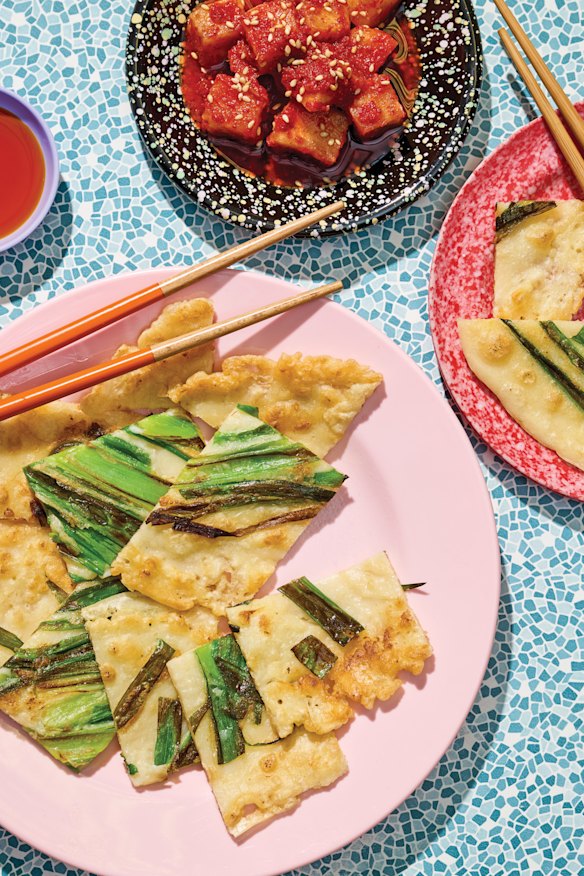
Pajeon (Spring onion pancake)
Pajeon is one of the most popular and traditional Korean pancakes. It’s easy to see why these are so beloved – it only takes a few minutes to whip up a batch, which is always satisfyingly impressive if friends drop by unexpectedly! Young, skinny, green spring onions are best for this recipe: the older, fatter ones can be a bit tough.
INGREDIENTS
- 1 x quantity Korean pancake mix (see recipe below)
- 4 spring onions
- vegetable oil, for frying
METHOD
- Prepare the pancake mix (see recipe below), then set aside.
- Trim the roots off the spring onions and cut into 8-10cm lengths. If the white parts are thick, split them in half lengthways.
- Heat 2 tablespoons vegetable oil in a 20cm non-stick frying pan over medium heat. Give the batter a quick stir then ladle half of the batter into the pan. Use the back of the ladle to spread the batter out to the edge of the pan. Lay half the spring onion in a single layer on top of the batter. Fry the pancake for 4-5 minutes, until golden brown on the bottom. Use a wide spatula to flip the pancake over. Cook for a further 4-5 minutes, until golden brown.
- Transfer the pancake to a baking tray lined with paper towel to soak up any excess oil. Repeat with the remaining batter and spring onion.
- Cut the pancakes into large squares and serve warm.
Note: You can also make garlic chive pancakes by substituting the spring onions for 50g garlic chives. They are just as good.
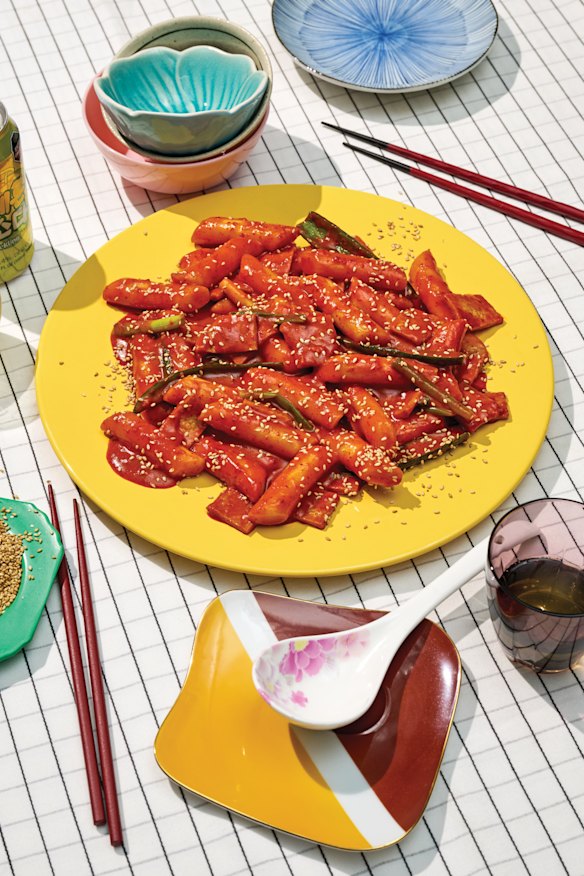
Tteokbokki (Traditional spicy rice cakes)
Tteokbokki is for sale on nearly every street corner in Korea – it’s a hugely comforting and soul-satisfying street food that’s beloved across the country. This recipe – stir-fried chewy rice cakes and fish cakes doused in a deep-red spicy sauce – is for a very typical, traditional tteokbokki, using inexpensive ingredients. Early versions of the dish date all the way back to the 1400s, and it re-emerged onto the scene in the late 1960s.
INGREDIENTS
- 500g frozen tteok (Korean tubular rice cakes)
- 1 tbsp olive oil
- 500ml (2 cups) vegetable stock
- 2 Korean fish cake sheets, cut into bite-sized pieces
- 2 spring onions, cut into 5cm lengths
- toasted sesame seeds, to serve
Tteokbokki sauce
- 3 garlic cloves, minced
- 2 tbsp gochugaru
- 100g (⅓ cup) gochujang
- 1 tbsp soy sauce
- 1 tbsp sugar
- 2 tsp sesame oil
METHOD
- Separate the frozen tteok into individual pieces, then soak them in warm water for 20 minutes to soften. Drain, then place the tteok in a bowl and toss with the olive oil until well coated so they don’t stick together.
- Pour the vegetable stock into a large, deep frypan over medium-high heat. Add the tteokbokki sauce ingredients, stir well to combine and bring to the boil. Add the tteok and cook, stirring frequently, for 8-10 minutes, until the tteok is very soft and the sauce is reduced and thick.
- Add the fish cake pieces to the pan, then reduce the heat to medium and simmer for 5 minutes. Taste and adjust the seasoning if needed. Add the spring onion, give everything a final stir, then transfer the stew to a serving dish. Sprinkle sesame seeds over the top and serve immediately.
Note: You can also add thin slices of fish cake to the dish.
Serves 4-6
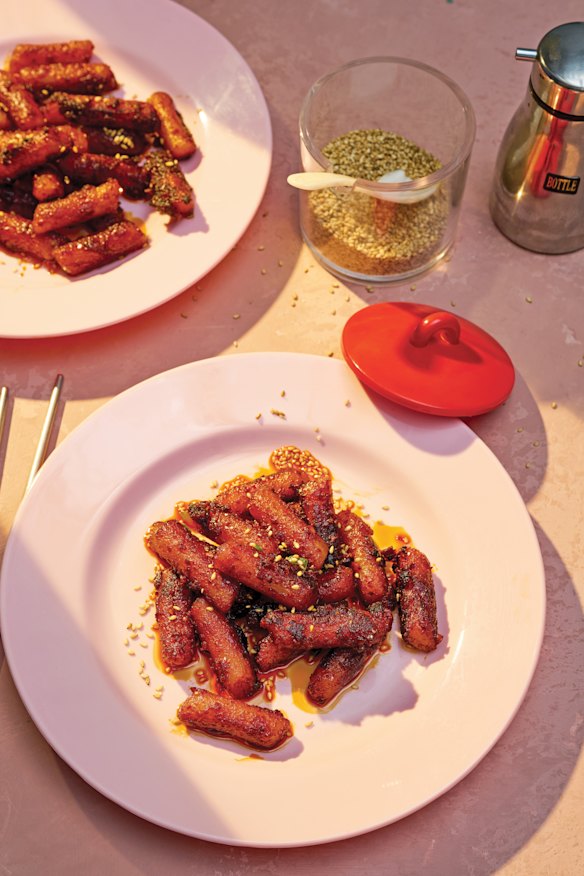
Gireum tteokbokki (Pan-fried spicy rice cakes)
Although tteokbokki is traditionally served in a spicy chilli sauce with fish cakes and other ingredients, I also love this simple, sauceless version that’s made by pan-frying the rice cakes to a lovely caramelised crisp finish. The flavour is intensified and the crispy-chewy rice cake is utterly satisfying, especially on a chilly day.
INGREDIENTS
- 500g frozen tteok (Korean tubular rice cakes)
- 1 tbsp olive oil
- 2 garlic cloves, finely chopped
- 2 tbsp gochugaru
- 70g (¼ cup) gochujang
- 2 tbsp soy sauce
- 1 tbsp caster sugar
- 2 tsp sesame oil
- pinch of freshly ground black pepper
- 1 spring onion, thinly sliced
- 2 tsp toasted sesame seeds
METHOD
- Bring a large saucepan of water to the boil over medium-high heat. Add the tteok and cook for 3 minutes or until soft. Drain, then transfer the rice cakes to a large bowl and drizzle with 1 tablespoon of the olive oil. Mix well to stop the tteok sticking together, then set aside.
- Combine the garlic, gochugaru, gochujang, soy sauce, sugar, sesame oil and black pepper in a small bowl, and mix well. Pour the mixture over the tteok and stir until they are well coated in the marinade. Cover with plastic wrap and leave to marinate at room temperature for at least 1 hour.
- Heat the remaining olive oil in a large non-stick frypan over medium-high heat. Working in small batches, fry the marinated tteok for 2-3 minutes, until crispy and slightly charred. Turn the tteok frequently so they don’t stick to the pan. Toss in the spring onion and sesame seeds, give it a quick stir, then dish up.
Serves 4
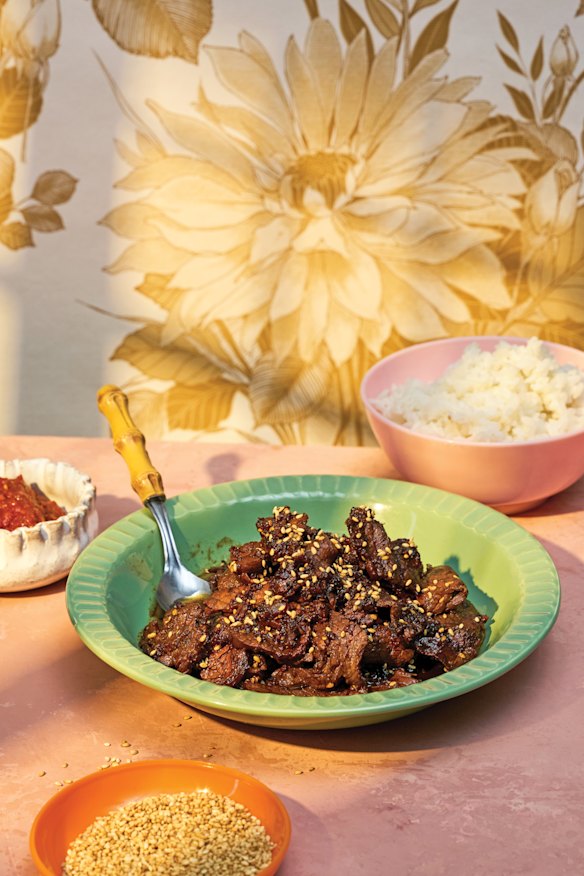
Bulgogi (Soy-marinated barbecued beef)
Bulgogi is a must at any Korean barbecue – the thinly sliced beef is marinated in a sweet soy marinade that starts to caramelise as soon as it hits the grill. Add the smoky flavour of the barbecue and it’s easy to see why this has become a global foodie superstar.
INGREDIENTS
- 1kg beef tenderloin or rib-eye (see note)
- 1 onion, sliced (optional)
- 3 spring onions, cut into 5cm lengths
- toasted sesame seeds, to serve
Sweet soy marinade
- 5 garlic cloves, crushed
- 2 tbsp caster sugar
- 60ml soy sauce
- 2 tbsp mirin
- 1 tbsp sesame oil
- 1 tsp freshly ground pepper
METHOD
- Cut the beef in half lengthways into two long strips, then slice each half against the grain into 3mm-thick slices. Combine the beef slices, onion (if using) and spring onion in a large bowl and set aside.
- To make the marinade, put all the ingredients in a bowl and stir until the sugar has dissolved. Pour the marinade over the beef and, using your hands, mix until well combined. Cover with plastic wrap and leave to marinate in the fridge for at least one hour.
- Set up a Korean barbecue grill plate on a portable gas stove in the centre of the dining table, or set a chargrill pan over high heat. Working in batches, chargrill the beef for 1-2 minutes each side until caramelised.
- Serve the barbecued beef sprinkled with toasted sesame seeds and with the spicy dipping sauce and a big bowl of steamed rice on the side.
Note: If you freeze your beef for about one hour before slicing it, it will be much easier to cut thinly.
Serves 4-6
Sigeumchi muchim (Seasoned English spinach)
Side dishes don’t come any more cleverly simple than this. Sigeumchi muchim is blanched English spinach seasoned with soy sauce, garlic and sesame oil. It’s quick, surprisingly delicious, and good for you, too.
INGREDIENTS
- 250-300g English spinach
- 1 garlic clove, finely chopped
- 1 tsp sesame oil
- 1 tsp toasted sesame seeds
- salt, to taste
METHOD
- Prepare a bowl of iced water and set aside.
- Wash the spinach under cold running water to remove any dirt. Shake off any excess water, then set aside.
- Bring a large saucepan of water to a rolling boil over high heat. Blanch the spinach for 30 seconds, then drain and immediately refresh in the iced water to stop the cooking process. Leave the spinach to chill in the water for 10 minutes, then drain and trim off the roots.
- Spread the spinach out on a chopping board, then cut the stems and leaves into 5cm lengths. Gather the spinach with both hands and squeeze firmly to remove any excess water. Loosen up the leaves and transfer to a mixing bowl.
- Add the garlic, sesame oil and sesame seeds and toss everything together with your hands. Season to taste with salt and serve right away or store in the fridge in an airtight container for up to two days.
Serves 4
Bibimjang (Bibim sauce)
Because bibim sauce is mainly used for bibimbap (see above), it’s easy to overlook that it’s also a very versatile chilli sauce. There’s nothing to stop you adding it to other dishes, whenever you feel like dialling up the spice.
INGREDIENTS
- 135g gochujang
- 2 tbsp sesame oil
- 1 tbsp caster sugar
- 1 tsp white vinegar
- 1 garlic clove, finely chopped
METHOD
- Combine all the ingredients in a small bowl and stir until the sugar has dissolved.
- Store in an airtight container in the fridge for up to two weeks.
- In addition to bibimbap, use this sauce as a condiment for sashimi rice bowls and other dishes.
Makes about 200ml
Kongnamul muchim (Seasoned soybean sprouts)
One of the most popular banchan in Korean cuisine, kongnamul muchim is served with almost every meal. It’s mildly seasoned, which enhances the natural nutty flavour of the sprouts, and it adds a wonderful crunch when used as a topping for bibimbap.
INGREDIENTS
- 1 tsp salt
- 450g soybean sprouts
- 2 garlic cloves, finely chopped
- 2 tsp toasted sesame seeds
- 1 spring onion, thinly sliced
- 1 tbsp fish sauce, or to taste
- 2 tsp sesame oil
METHOD
- Prepare a bowl of iced water and set aside.
- Combine 1 litre (4 cups) of water and the salt in a large saucepan and bring to the boil over medium-high heat. Add the bean sprouts and boil, covered, for 5 minutes or until softened and translucent. Do not remove the lid during cooking or the sprouts will have an unpleasant aftertaste. Once cooked, drain them immediately and refresh in the iced water for 5 minutes to stop the cooking process. Drain, shaking off any excess water, and transfer to a mixing bowl.
- Add the garlic, sesame seeds, spring onion, fish sauce and sesame oil and mix everything together well. Serve immediately, or store in the fridge in an airtight container for up to two days.
Note: For a spicy version, add 2 teaspoons of gochugaru to the mix.
Serves 4
Hobak muchim (Sauteed zucchini)
Many banchan are extremely easy to whip up with just a few ingredients, and this one’s a great example. The zucchini is salted for an hour or so, but that takes no effort at all and, once you’re ready to cook, hobak muchim can be on the table in a couple of minutes. It’s also used as one of the toppings for bibimbap.
INGREDIENTS
- 2 zucchini, unpeeled, washed
- ⅛ tsp salt, plus extra for seasoning
- 1 tbsp vegetable oil
- 2 garlic cloves, finely chopped
METHOD
- Cut the zucchini crossways into 3mm-thick slices and transfer to a bowl. Add the salt and give it a quick toss, then set aside for 1 hour. Strain the zucchini in a fine-mesh sieve.
- Heat the vegetable oil in a frying pan over medium heat. Add the zucchini and fry gently for 2-3 minutes, until just tender. Add the garlic, 2 tablespoons of water and season to taste with salt. Saute for another minute or until the zucchini is softened but not mushy.
- Transfer to a serving plate and serve at room temperature.
Serves 4
Gosari namul (Sauteed fernbrake)
Fernbrake, or bracken, is sometimes dubbed “the beef of the mountains” due to its high protein content. Gosari are its young stems and they can be bought dried in packets at the grocery store. Sauteed gosari is prized for its chewy texture and earthy flavour and is a favourite dish for festive holidays. This is also another popular topping for bibimbap.
INGREDIENTS
- 50g dried fernbrake (see note)
- pinch of salt
- 1 tbsp vegetable oil
- 2 garlic cloves, finely chopped
- 2 tbsp soy sauce
- 2 tbsp mirin
- 1 tsp caster sugar
- 2 spring onions, thinly sliced
- freshly ground black pepper, to taste
- 1 tbsp sesame oil
- toasted sesame seeds, to serve
METHOD
- Put the dried fernbrake in a heatproof bowl. Bring 1 litre (4 cups) of water to the boil in a kettle and pour the boiling water over the fernbrake. Leave to steep for at least 1 hour to rehydrate the fernbrake. Drain, and transfer the fernbrake to a large saucepan. Cover the fernbrake with water, add a pinch of salt and bring to the boil over high heat. Reduce the heat to medium-high and boil for 10 minutes or until the fernbrake has softened.
- Drain and rinse the fernbrake twice under cold running water. Squeeze the fernbrake gently to remove as much water as possible and set aside. Line up the stems of the fernbrake, trim off any woody bits and discard, then cut the stems into 10cm lengths.
- Heat the vegetable oil in a frying pan over medium heat. Add the garlic and fernbrake and saute for 3 minutes or until fragrant. Add the soy sauce, mirin, sugar and spring onion, and saute for another 3 minutes or until the fernbrake has softened and most of the liquid has evaporated. Taste and adjust the seasoning if necessary.
- Remove from the heat, season with pepper to taste and add the sesame oil. Give it a quick stir, then leave to cool to room temperature before serving, garnished with sesame seeds.
Serves 4
Note: Fernbrake (gosari in Korean) is also called bracken. You can find it at any Korean grocery store. It usually comes dried and is sold by the packet.
(Doraji namul) Sauteed bellflower root
The bellflower plant grows wild in the mountains of Korea; its root (doraji) is a popular ingredient in traditional cooking and as a topping for bibimbap. Doraji has long been used in herbal medicine to treat inflammation and allergies. The root is crunchy yet chewy once cooked, but it can be quite bitter if not prepared properly – so don’t skip the salting step, which will get rid of that bitterness.
INGREDIENTS
- 100g dried bellflower roots (see note)
- 1 tbsp coarse cooking salt
- 1 tbsp vegetable oil
- 2 tsp fish sauce
- 1 garlic clove, finely chopped
- 1 spring onion, green part only, thinly sliced
METHOD
- Soak the dried bellflower roots in water for 8-12 hours, or overnight, to rehydrate. The next day, drain the water. The hydrated roots should be about 5mm thick. If there are any larger pieces, split them into thinner strips.
- Transfer the roots to a large bowl, sprinkle with the salt and mix well. Rub the roots against a chopping board for a couple of minutes to help remove the bitterness. Rinse the roots under cold running water a couple of times, then squeeze out as much water as possible. Set aside.
- Heat the vegetable oil in a frying pan over medium heat. Saute the bellflower roots for 3-4 minutes, until lightly browned. Add the fish sauce and 60ml (¼ cup) of water, and saute for a further 8-10 minutes, until the water has evaporated and the bellflower roots have turned slightly opaque. Add the garlic and spring onion and give it a quick stir, then turn off the heat. Transfer to a serving plate and allow to cool to room temperature before serving.
Note: Bellflower root (doraji in Korean) is also known as balloon flower or platycodon. You can find it at any Korean grocery store. It usually comes in dried form and is sold by the packet.
Serves 4
(Jeon garu) Korean pancake mix
The key to a good jeon lies in the batter. It shouldn’t be too dense or too thin, but just thick enough to hold the ingredients together. Slow pan-frying will turn it into a golden crispy pancake that is still soft and chewy (but never soggy) in the middle. Of course, you could just use store-bought pancake mix – but where’s the fun in that?
INGREDIENTS
- 110g plain flour
- 2 tbsp rice flour
- 2 tbsp cornflour
- ¼ tsp salt
- ½ tsp baking powder
- 2 garlic cloves, finely chopped
- 2cm piece of ginger, peeled and finely chopped
- 1 egg, lightly beaten
METHOD
- Sift all the dry ingredients into a mixing bowl and stir to combine. Add the garlic and ginger, 185ml (¾ cup) of iced water and the egg, and whisk until the batter is smooth with no lumps. Add a little more water to loosen the batter if necessary. It should be thick but still runny, with the consistency of pouring cream.
- Use this batter to make any of the pancakes or fritters in this book.
Makes 2 x 20cm pancakes

This is an edited extract from Cook Korea! by Billy Law, published by Smith Street Books, RRP $49.99. Photography by Daniel Herrmann-Zoll.
The best recipes from Australia’s leading chefs straight to your inbox.
You have reached your maximum number of saved items.
Remove items from your saved list to add more.


